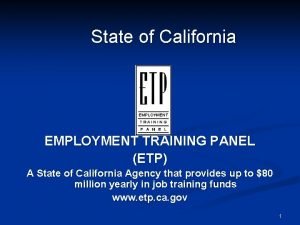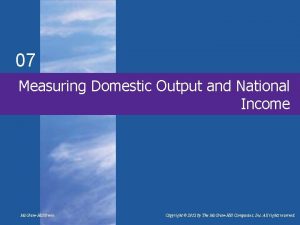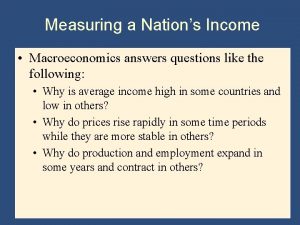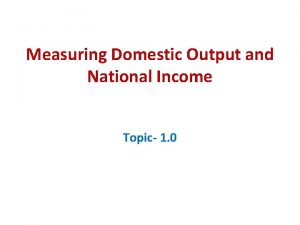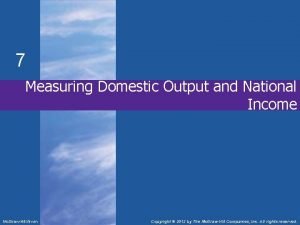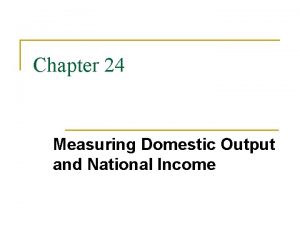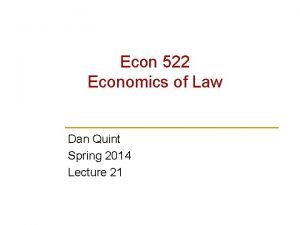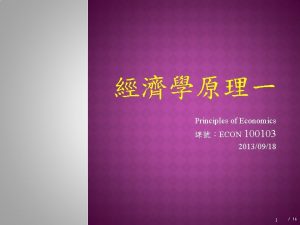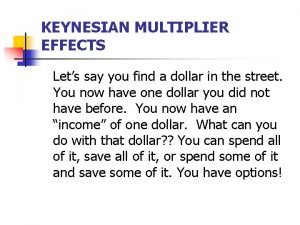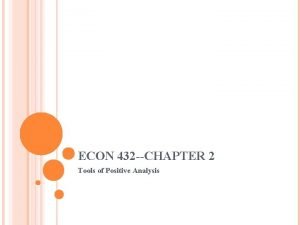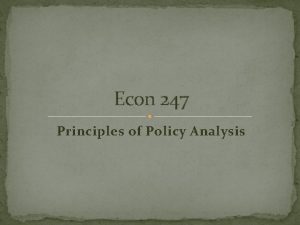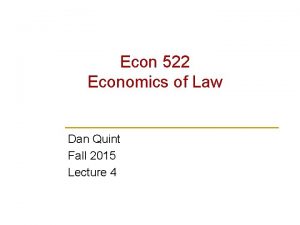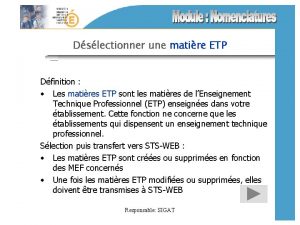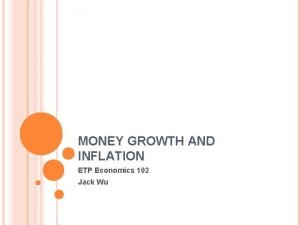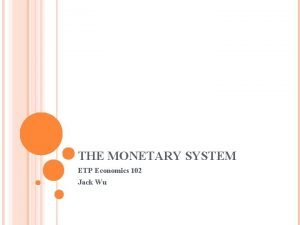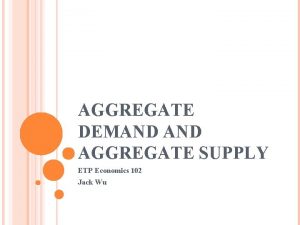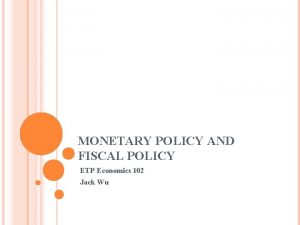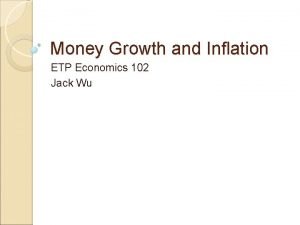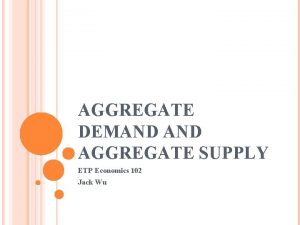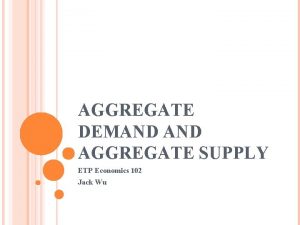Measuring a Nations Income ETP Economics 102 Econ

































- Slides: 33

Measuring a Nation’s Income ETP Economics 102

Econ 101 and Econ 102 n Microeconomics (Econ 101) ¡ n Microeconomics is the study of how individual households and firms make decisions and how they interact with one another in markets. Macroeconomics (Econ 102) ¡ ¡ Macroeconomics is the study of the economy as a whole. Its goal is to explain the economic changes that affect many households, firms, and markets at once.

Examples of Macroeconomic Questions n Macroeconomics answers questions like the following: ¡ ¡ ¡ Why is average income high in some countries and low in others? Why do prices rise rapidly in some time periods while they are more stable in others? Why do production and employment expand in some years and contract in others?

Economy’s Income and Expenditure n n When judging whether the economy is doing well or poorly, it is natural to look at the total income that everyone in the economy is earning. For an economy as a whole, income must equal expenditure because: ¡ ¡ Every transaction has a buyer and a seller. Every dollar of spending by some buyer is a dollar of income for some seller.

Gross Domestic Product n n n Gross domestic product (GDP) is a measure of the income and expenditures of an economy. It is the total market value of all final goods and services produced within a country in a given period of time. The equality of income and expenditure can be illustrated with the circular-flow diagram.

MARKETS FOR GOODS AND SERVICES • Firms sell Goods • Households buy and services sold Revenue Wages, rent, and profit Goods and services bought HOUSEHOLDS • Buy and consume goods and services • Own and sell factors of production FIRMS • Produce and sell goods and services • Hire and use factors of production Factors of production Spending MARKETS FOR FACTORS OF PRODUCTION • Households sell • Firms buy Labor, land, and capital Income = Flow of inputs and outputs = Flow of dollars Copyright © 2004 South-Western

Definition of GDP n “GDP is the Market Value. . . ” ¡ n “. . . Of All Final. . . ” ¡ n Output is valued at market prices. It records only the value of final goods, not intermediate goods (the value is counted only once). “. . . Goods and Services. . . “ ¡ It includes both tangible goods (food, clothing, cars) and intangible services (haircuts, housecleaning, doctor visits).

Definition of GDP n “. . . Produced. . . ” ¡ n “. . . Within a Country. . . ” ¡ n It includes goods and services currently produced, not transactions involving goods produced in the past. It measures the value of production within the geographic confines of a country. “. . . In a Given Period of Time. ” ¡ It measures the value of production that takes place within a specific interval of time, usually a year or a quarter (three months).

Components of GDP n n GDP includes all items produced in the economy and sold legally in markets. What Is Not Counted in GDP? ¡ ¡ GDP excludes most items that are produced and consumed at home and that never enter the marketplace. It excludes items produced and sold illicitly, such as illegal drugs.

Formula of GDP n GDP (Y) is the sum of the following: ¡ ¡ Consumption (C) Investment (I) Government Purchases (G) Net Exports (NX) Y = C + I + G + NX

Components: C and I n Consumption (C): ¡ n The spending by households on goods and services, with the exception of purchases of new housing. Investment (I): ¡ The spending on capital equipment, inventories, and structures, including new housing.

Components: G and NX n Government Purchases (G): ¡ ¡ n The spending on goods and services by local, state, and federal governments. Does not include transfer payments because they are not made in exchange for currently produced goods or services. Net Exports (NX): ¡ Exports minus imports.

Assignment n n Find statistical numbers of components of Taiwan’s GDP. Data Source: http: //eng. dgbas. gov. tw

Nominal Versus Real GDP n n Nominal GDP values the production of goods and services at current prices. Real GDP values the production of goods and services at constant prices.

Example Copyright© 2004 South-Western

Example: Continued Copyright© 2004 South-Western

Example: Continued Copyright© 2004 South-Western

GDP deflator n n n An accurate view of the economy requires adjusting nominal to real GDP by using the GDP deflator. The GDP deflator is a measure of the price level calculated as the ratio of nominal GDP to real GDP times 100. It tells us the rise in nominal GDP that is attributable to a rise in prices rather than a rise in the quantities produced.

The GDP Deflator n The GDP deflator is calculated as follows:

Example: Continued Copyright© 2004 South-Western

The GDP Deflator n Converting Nominal GDP to Real GDP ¡ Nominal GDP is converted to real GDP as follows:

GDP and Economic Well. Being n n GDP is the best single measure of the economic well-being of a society. GDP person tells us the income and expenditure of the average person in the economy. Higher GDP person indicates a higher standard of living. GDP is not a perfect measure of the happiness or quality of life, however.

GDP and Economic Well. Being n Some things that contribute to wellbeing are not included in GDP. ¡ ¡ ¡ The value of leisure. The value of a clean environment. The value of almost all activity that takes place outside of markets, such as the value of the time parents spend with their children and the value of volunteer work.

Other Measures of Income n n n Gross National Product (GNP) Net National Product (NNP) National Income (NI) Personal Income (PI) Disposable Personal Income (DPI)

Gross National Product n GNP is the total income earned by a nation’s permanent residents. It differs from GDP by including income that citizens earn abroad and excluding income that foreigners earn here.

Net National Product n NNP is the total income of a nation’s residents (GNP) minus losses from depreciation (“consumption of fixed capital).

National Income n n NI is the total income earned by a nation’s residents in the production of goods and services. It differs from NNP by excluding indirect business taxes (such as sales taxes) and including business subsidy.

Personal Income n n PI is the income that households and noncorporate businesses receive. Unlike NI, it excludes retained earnings and subtracts corporate income taxes and contributions for social insurance. It also includes interest incomes from holding government bonds and government transfer payments.

Disposable Personal Income n DPI is the income that households and non-corporate businesses have left after satisfying all their obligations to the government (such as personal taxes).

Example GDP $110 Income Earned by Citizens Abroad $5 Income Foreigners Earn Here $15 Depreciation $4 Indirect Business Taxes $6 Business Subsidies $2 Retained Earnings $5 Corporate Income Taxes $6 Social Insurance Contributions $10 Interest Paid to Households by Government $5 Transfer Payments to Households from Government $15 Personal Taxes $30 Non-Tax Payments to Government $5

Calculation n n GNP=100+5 -15=100 NNP=100 -4=96 NI=96 -6+2=92 PI=92 -5 -6 -10+5+15=91 DPI=91 -30 -5=56

Green GDP n n Green GDP is an index of economic growth with the environmental consequences of that growth factored in. Green GDP=Traditional GDPenvironmental/ecological costs

Discussion questions n n Identify the immediate effect of each of the following circumstances on U. S. GDP and its components. a. James receives a unemployment compensation check. b. John buys an Italian sports car. c. Henry buys domestically produced tools for his construction company.
 Strathclyde strategic themes
Strathclyde strategic themes Etp pharmacy
Etp pharmacy California etp program
California etp program Measuring domestic output and national income
Measuring domestic output and national income Measuring a nation's income
Measuring a nation's income Outputs
Outputs Measuring domestic output and national income
Measuring domestic output and national income Measuring domestic output and national income
Measuring domestic output and national income Accounting income vs taxable income
Accounting income vs taxable income National income accounting
National income accounting Deferred tax asset and liability
Deferred tax asset and liability Partnership income statement format
Partnership income statement format Economics and business economics maastricht
Economics and business economics maastricht What is mathematical economics
What is mathematical economics Fiscal policy ib definition
Fiscal policy ib definition Econ
Econ Econ muni
Econ muni Chapter 15 monopoly
Chapter 15 monopoly Nthu econ
Nthu econ Econ 134
Econ 134 Spending multiplier
Spending multiplier Gertler econ
Gertler econ Econ 432
Econ 432 Econ
Econ Mpc economics
Mpc economics Econ
Econ Econ
Econ Econ 152
Econ 152 Econ
Econ Econ 247
Econ 247 Econ 424
Econ 424 Econ
Econ Flipit econ
Flipit econ Econ
Econ


